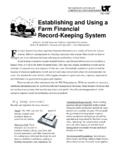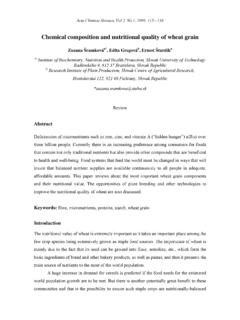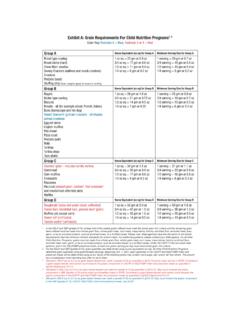Transcription of Grain Handling and Storage Costs in Country Elevators
1 Grain Handling and Storage Costs in Country Elevators Phil Kenkel Bill Fitzwater Cooperative Chair Department of Agricultural Economics Oklahoma State University 405-744-9818 Grain Handling and Storage Costs in Country Elevators Grain Handling and Storage Costs have increased dramatically due to recent increases in commodity prices, labor rates, and utility Costs . A typical elevator s interest Costs have more than doubled during the last year (Anderson) while commercial electricity Costs have increased almost 19% during the last five years and are forecast to continue to increase at a similar rate (EIA). In order to establish adequate margins on Grain sales and contracts and to set appropriate Storage fees, managers need accurate information on Grain Handling Costs . Unfortunately, many mangers rely on outdated rules of thumb rather than accurate measurements of Handling Costs . This study provides information on Grain Handling Costs at Country Elevators .
2 Previous Research Research on Grain Handling and Storage Costs is limited. A 1983 study (Schnake and Stevens ) provides engineering-based Handling cost estimates for various sizes of corn and soybean and wheat and sorghum Elevators . Schnake and Steven s model suggests substantial economies of scale in per-bushel Handling Costs . For corn and soybean Elevators , the estimated per-bushel Handling cost ranges from $ for an elevator with bushels of throughput to $ for an elevator with bushels of annual volume. The results also indicate minor cost differences between corn and soybean and wheat and sorghum Elevators . Kenkel and Anderson and report Grain Handling Costs for five size categories of wheat Elevators based on a survey conducted in 1991. The authors report Handling Costs ranging from $ to $ , but they do not report a clear relationship between Costs and throughput. Baumel gathered information on Handling Costs of ten corn and soybean Elevators in Iowa across two crop years (1993-94 and 1994-95).
3 The results highlight the importance of capacity utilization with the average-per bushel Handling Costs averaging $ in 1993-94 on an average throughput of bushels and falling to $ when increased crop production increases average throughput to bushels. The time span of the previous estimates of elevator Handling Costs obviously makes direct comparison inappropriate. A conversion of the previous cost estimates to 2008 dollars using the producer price index is provided in Table 1. The adjusted estimates still reflect considerable variation due to elevator size and throughput with corn and soybean elevator Handling Costs ranging from $.07 to $.23 per bushel and wheat elevator Handling Costs ranging from $.07 to $.29 per bushel. Somewhat reassuring is that the survey based estimates (Kenkel and Anderson and Baumel) fall within the range of the engineering based projection (Schnake and Stevens). Table 1: elevator Handling cost Estimates Converted to 2008 Dollars* Type of elevator Corn and Soybean Corn and Soybean Wheat and Sorghum Wheat Year of Study 1982 1993 1982 1991 Per Bushel cost (unadjusted) $.
4 073 to $.270 $ $.074 to $.294 $.172 to $.224 Per Bushel cost (adjusted to 2008) $.131 to $.486 $.218 $.133 to $.530 $.250 to .326 Source Schnake and Stevens Braumel Schnake and Stevens Kenkel and Anderson *US Department of Labor, Bureau of Labor Statistics The breakdown between fixed and variable Storage Costs is also an important consideration for elevator managers. Because fixed Costs have historically accounted for around two thirds of an elevator s total Costs , managers attempt to maximize Grain throughput. Weather and crop production factors are the largest determinant of volume, but are obviously outside of the manager s control. elevator managers are therefore pressured to reduce Grain margins below the total cost of Handling to attempt to capture a higher share of the Grain produced in their procurement region. A study of pricing strategies of Country corn Elevators (Davis and Hill) concludes that the competition among Elevators for a fixed amount of corn pushed all Elevators to match margins with the highest pricing competitor.
5 Surveys of cooperative Elevators (Gumn and Cobia, Stearns and Cobia, Stearns, Cobia and Warman) also conclude that managers closely monitor competitors when setting Grain margins. Reducing margins to gain throughput can be an effective short-run strategy only if the competitors do not respond and if the margin exceeds the variable Costs of Storage . Fixed Costs make up a relatively large component of the total Costs for a commercial Grain operation. Schnake and Stevens estimate that fixed Costs for corn and sorghum Elevators average 64% of total Costs , while wheat and sorghum Elevators average 60%. Kenkel and Anderson report an average fixed/total cost ratio of 77%. Baumel s results indicate a fixed/total cost ratio of only 50%. However, his cost breakdown does not separate administrative personnel Costs from the total personnel Costs , which are treated as a variable expense. Modeling Grain Handling Costs A Grain Handling and Storage cost template was recently developed by Oklahoma State University.
6 The template was developed to allow Grain elevator managers to estimate Grain Handling Costs and analyze changing cost factors, The software uses an economic engineering approach to model Grain Handling Costs based on Grain prices, electricity price, turning and aeration practices, and other inputs supplied by the user. Economic engineering uses engineering data to estimate facility, equipment, labor, and utility requirements. The economic component of the model determines the fixed and variable Costs associated with operating the facility (Criner and Jacobs). Variable Grain Storage and Handling Costs include Grain shrinkage and moisture loss, electricity for elevation, conveying, turning and aeration, and fumigation expenses. Grain shrinkage, which is also referred to as Handling loss, is the invisible loss in weight that occurs during the Storage period. Causes for Handling loss include broken kernels and dust during Handling , transportation, the loss of volatile compounds such as oils, and possible losses due to seed respiration (Summer).
7 Research at Iowa State University determined that Handling losses at commercial Elevators range from to with a three-year average of (Hicks and Cloud). elevator managers often assume Handling losses of for elevation and discharge (in and out) plus for each time the Grain is turned. While the Handling loss percentage is predictable, the economic consequences vary with the value of the Grain . Moisture loss is another source of shrinkage in Grain Storage and Handling . The moisture weight loss that occurs as Grain dries is not linearly related to the change in moisture percentage, but can be calculated by determining the water weight loss as a percentage of the total original weight of Grain and moisture. The change in weight can be calculated from the formula: %))100(%)100((moisturefinalmoistureiniti alweightinitialtFinalWeigh = For example, 1000 lbs of Grain at an initial moisture content of 25% will have a final weight of 882 lbs if dried to 15% moisture [1000 x (75/85)].
8 The weight loss of 118 lbs represents of the initial weight, which is greater than the 10% change in moisture content. Managers of corn Elevators are often familiar with moisture loss calculations, because they include moisture loss as part of their drying fees. In other grains such as soybeans or wheat which are received at moisture content closer to equilibrium Storage moisture, the potential for moisture loss is more subtle. Wheat delivered to an elevator at an average moisture content of 13% is likely to decrease in moisture content as it is aerated and handled. If the wheat is removed from the elevator at a moisture content of 12%, the elevator will suffer shrinkage from moisture loss. The economic implications of moisture shrinkage, like Handling shrinkage, increase as the value of the commodity increases. Electricity usage during Grain Handling and Storage is a function of conveying, elevation, dust control systems, and aeration equipment. Per-bushel electricity Costs vary with the equipment configuration and electricity rates.
9 A typical configuration for a Country elevator might include a 10,000 bushel/hour leg equipped with a 50 horsepower motor, a drag conveyor with a 25 HP motor, and a dust control system using 15 HP resulting in 90 HP. A three-phase 225 volt electric motor draws approximately .75KW/HP for each hour of use. For older motors, the simple rule of thumb of one kilowatt per horsepower provides a reasonable estimate. At an electrical rate of $.10/KW the previously described Handling system results in electrical Costs of $.003 for each bushel elevated, turned, and then removed from Storage . The operation of aeration equipment is typically a more major component of electricity use. A typical aeration system with 1/10 cubic foot/minute airflow requires .007HP/bushel of bin capacity, and the system will need to operate for 150-170 hours per aeration cycle. At $.10/KW this equates to $.005/bushel for each aeration cycle. Aeration practices vary widely across Elevators .
10 Some managers strive for a single aeration to cool Grain while other managers aerate four or more times per year to minimize the differential between the Grain and the outside temperature. Wheat Storage typically makes more intensive use of aeration because the Grain in placed into Storage during the summer. In addition to electricity consumption charges, which are based on the kilowatts of electricity consumed, many Elevators face demand charges calculated on peak consumption and/or differential charges based on the daily timing of electricity use. Demand charges vary greatly and may represent 25-50% of electricity Costs . In some cases, the peak consumption impacts the rate that the business pays for all electricity usage. Demand charges can be reduced by staging the startup of large motors and through judiciously selecting the equipment that operates at the same time. Fumigation and Grain treatment Costs vary across grains and Storage environments. Wheat Elevators typically fumigate wheat at least once during the Storage period.








